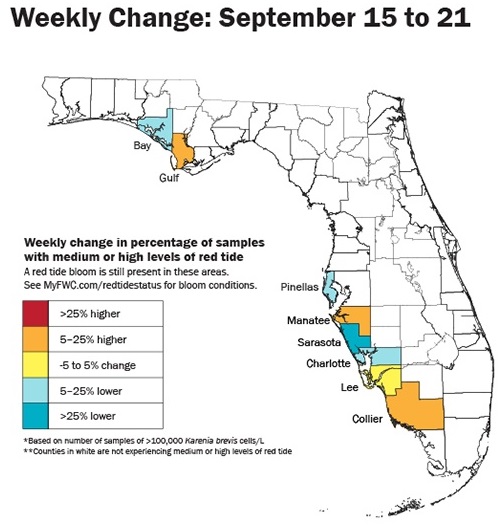 A bloom of the Florida red tide organism, Karenia brevis, persists in Southwest Florida and extends along ~135 miles of coastline, from northern Pinellas to northern Collier counties, and extends offshore (10 miles or more). A patchy bloom of K. brevis also continues in Northwest Florida. Additional details are provided below.
A bloom of the Florida red tide organism, Karenia brevis, persists in Southwest Florida and extends along ~135 miles of coastline, from northern Pinellas to northern Collier counties, and extends offshore (10 miles or more). A patchy bloom of K. brevis also continues in Northwest Florida. Additional details are provided below.
Over the past week in Southwest Florida, K. brevis concentrations generally decreased in areas of Pinellas, Sarasota, and Charlotte counties and increased in northern Manatee County, parts of Lee County, and northern Collier County. Observations of >1,000,000 K. brevis cells per liter (“high” concentrations) occurred in Pinellas, Manatee, Sarasota, Charlotte, and Lee counties and >15 miles offshore of Sarasota, Lee and Collier counties. In Northwest Florida, K. brevis was observed in Okaloosa, Bay, Gulf, and Pasco counties, with up to “medium” concentrations observed in Gulf County only. Relative to last week, cell counts generally decreased in Bay County.
In Southwest Florida over the past week, K. brevis was observed at background to high concentrations in or offshore of Pinellas County, background to high concentrations in or offshore of Manatee County, background to high concentrations in or offshore of Sarasota County, very low to high concentrations in or offshore of Charlotte County, background to high concentrations in or offshore of Lee County, and very low to high concentrations in or offshore of Collier County. In Northwest Florida over the past week, K. brevis was observed at very low to low concentrations in or offshore of Okaloosa County, low concentrations in Bay County, background to medium concentrations in Gulf County, and background to very low concentrations in or offshore of Pasco County. Additional samples collected throughout Florida over the past week did not contain K. brevis.
We continue to receive reports of fish kills related to Florida red tide. In Southwest Florida, reports of fish kills were received for multiple locations in and/or offshore of Pinellas, Manatee, Sarasota, Charlotte, and Lee counties and one location offshore of Collier County. In Northwest Florida, reports of fish kills were received for Walton, Bay and Gulf counties. More detailed information is available at http://myfwc.com/fishkill. Respiratory irritation was reported over the past week in Southwest Florida (in Pinellas, Manatee, Sarasota, and Lee counties) and in Northwest Florida (in Gulf County).
Forecasts by the USF-FWC Collaboration for Prediction of Red Tides for Pinellas to northern Monroe counties predict net southwestern movement of surface waters and net southeastern transport of subsurface waters for most areas over the next three days. Three-day forecasts for Northwest Florida predict net eastern transport of surface waters and northeastern movement of subsurface waters from Escambia to western Gulf counties.
This information, including maps and reports with additional details, is also available on the FWRI Red Tide website. The website also provides links to additional information related to the topic of Florida red tide including satellite imagery, experimental red tide forecasts, shellfish harvesting areas, the FWC Fish Kill Hotline, the Florida Poison Information Center (to report human health effects related to exposure to red tide), and other wildlife related hotlines.
To learn more about various organisms that have been known to cause algal blooms in Florida waters, see the FWRI Red Tide Flickr page. Archived status maps can also be found on Flickr.
The FWRI HAB group in conjunction with Mote Marine Laboratory now have a Facebook page. Please like our page and learn interesting facts concerning red tide and other harmful algal blooms in Florida.
Additional information regarding the current status of algal blooms in South Florida is being consolidated and posted on the Florida Department of Environmental Protection’s website: https://floridadep.gov/dear/algal-bloom. Fact Sheet on Red Tide – https://floridadep.gov/sites/default/files/freshwater-algal-bloom-faq.pdf
